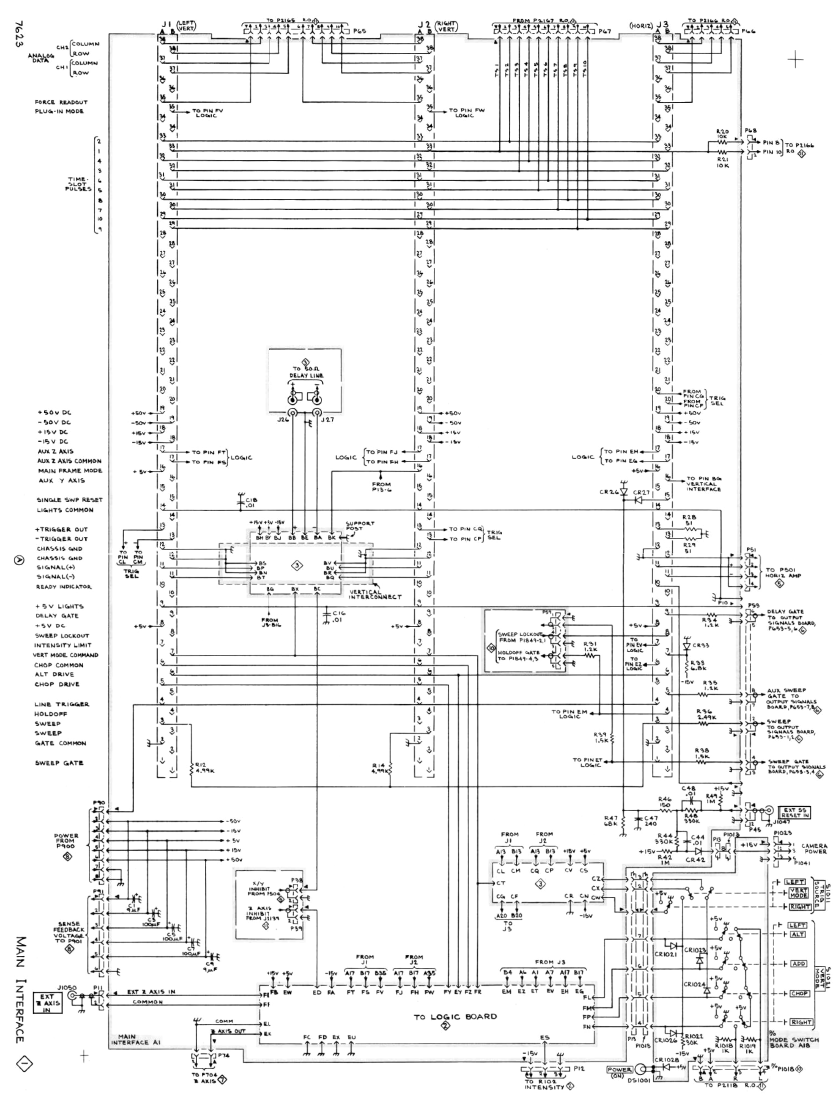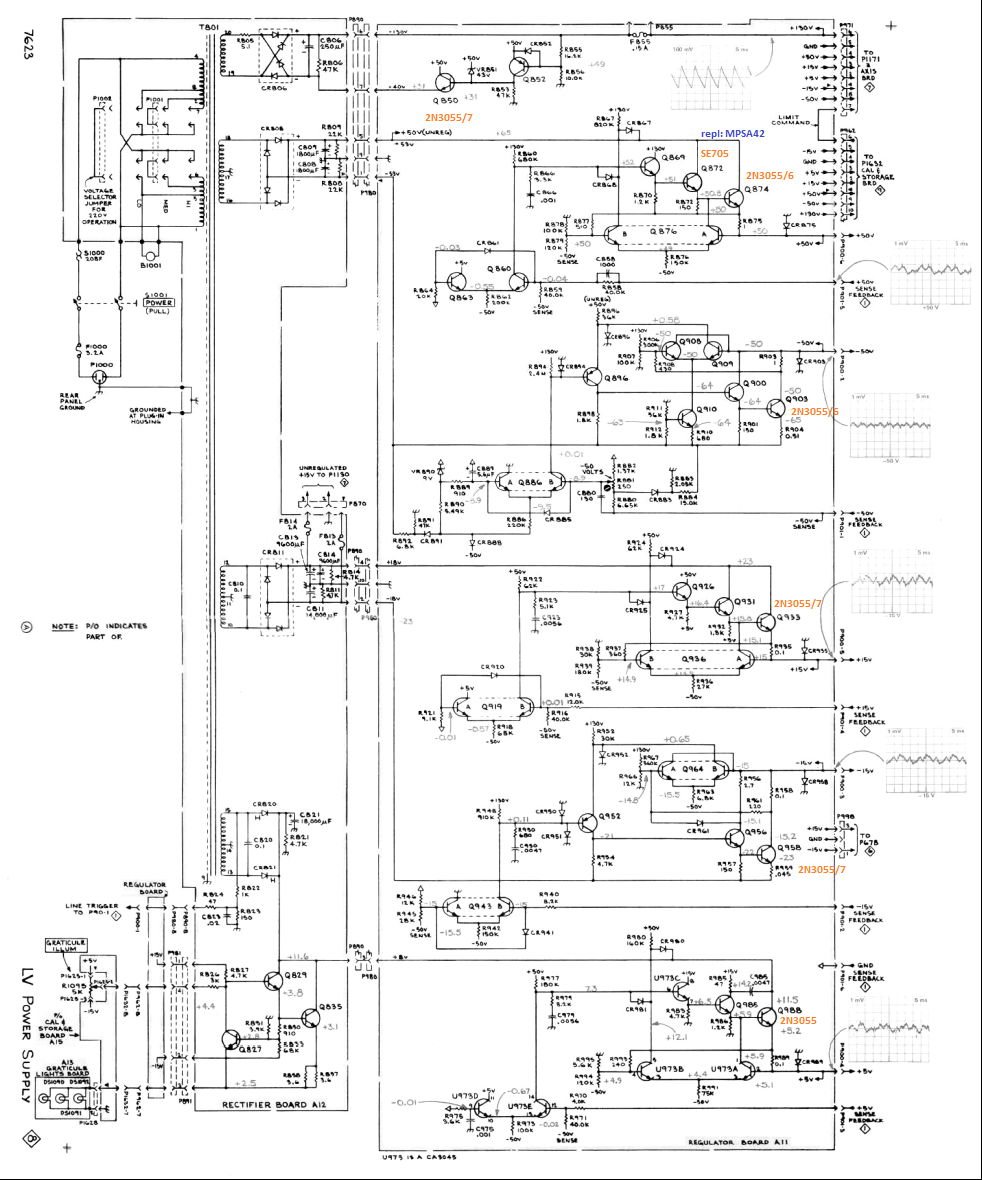Projekt TekRep7k: Unterschied zwischen den Versionen
Keine Bearbeitungszusammenfassung |
Keine Bearbeitungszusammenfassung |
||
| Zeile 15: | Zeile 15: | ||
Additionally, [http://w140.com/tekwiki/images/0/0c/Email_address.gif Kurt] at [[http://w140.com/tekwiki/ TekWiki] ([http://w140.com/tekwiki/wiki/7623 The Tekwiki 7623 Page]) did and still does an incredible job in collecting and documenting all things Tektronix. | Additionally, [http://w140.com/tekwiki/images/0/0c/Email_address.gif Kurt] at [[http://w140.com/tekwiki/ TekWiki] ([http://w140.com/tekwiki/wiki/7623 The Tekwiki 7623 Page]) did and still does an incredible job in collecting and documenting all things Tektronix. | ||
== Resources == | |||
* {{PubImg|Hardware/MessWerkZeuge/Tektronix_7000}} | |||
== The repair log == | |||
=== 02.11.2015 === | === 02.11.2015 === | ||
Version vom 12. Dezember 2015, 23:26 Uhr
On ebay I found a Tektronix 7623 Oscilloscope "for Parts" for only 30.- EUR. The 7623 is not the top-of-the-line of the Tektronix 7000 Series and the thing might have been dead as a doornail but for 30 EUR I decided to take the risk and got it sent to me.
In my hardware time in the 1980's the Tek 7000 line was sort of the holy grail of oscilloscopes with all high quality features, modular plug-in architecture and a On-Screen readout. Of course it came with the associated steep price tag, so being able to own such a beast even after more that 30 Years and even having to repair it myself sounded very attractive.
The interesting feature of the 7623 is that it is a CRT variable storage oscilloscope, a Tek speciality and there also only found in 2 models.
At first power-on, the only parts showing activity was the cooling fan and the graticule lighting. No Beam on the CRT, no lighted knobs.
So, into the repair job. The 7623 being a product of the 1980s helps with DIY repair, because:
- Most parts are more-or-less standard through-hole low integration parts like single transistors and SSI TTL 74xx ICs
- The size of the parts compared to today's SMD components renders them recognizable to even a myopic 50+ person like myself
- The vendors at that time, especially the likes of Tektronix, made tremedously good maintenance manuals, containing not only calibration instructions but also complete schematics, layout drawings and explanatory texts about how the product is supposed to work, down to each individual transistor
Additionally, Kurt at [TekWiki (The Tekwiki 7623 Page) did and still does an incredible job in collecting and documenting all things Tektronix.
Resources
The repair log
02.11.2015
Openening the case revealed the first bad news:
- The vertical Amplifier board had clearly seen a previous bad repair job replacing one of the 2 special ceramic high power resistors
- The fine mains voltage selector which allows (in the 220V position of the coarse voltage selector) to select between mains voltages of 220V/230V and 240V was in the 220V position, which, considering that the Austrian power grid delivers 230V since a few years, produces a 5% to 10% higher input voltage to the Power Supply boards ( as the Power Supply is purely linear with a real big and heavy transformer)
Measuring the 1,4kV test point on the High Voltage (HV) Supply board revealed that the high voltages were not present.
The 2Afast Fuse feeding the HV board with 15 VDC unregulated had been blown and already replaced by a similar one, but being in Europe and 32x6mm Fuses not available, by a 15x4mm Fuse soldered onto the defective bigger one. Unfortunately, the replacement Fuse also was blown.
Fortunately, I could get a pack of 2Afast 32x6mm Fuses at Conrad.
Additionally, disassembling the HV board showed a desintegrated 10uF / 60V electrolytic capacitor, which I replaced.
The HV board consists of an oscillator, built from standard 2N3055 transistors and a transformer with following voltage multiplier. To be safe I got me some 2N3055s, which I did not need yet because testing them showed them appearently fine.
Supplying the HV board with 15V did not start the oscillator, therefore no HV.
Interestingly, touching a point on the base of one of the oscillator transistors with a multimeter probe cable seemed to start the oscillator, although the sound made by the transformer indicated it being not very happy. Removing the probe let the osciallator die again.
Sadly, when letting the oscillator run a longer time, the +130V supply seemed to have died: the Fuse in the 130V line was blown and the excess current still stayed even when disconnecting everything from the LV PS board.
09.11.2015
There was a "mystery wire" inside the 7623 from the LV supply board running to the plug-in-backpanel:
20.11.2015
To be sure, I ordered some of the more frequently used parts that were still available on AliExpress or wih Conrad:
- 2N5551 - 20 Pcs
- 2N2905 - 20 Pcs
- 2N???? - 10 Pcs (dual transistor in TO39 package)
- CA3045 (transistor array in DIL14 package) - 3 Pcs
05.12.2015
The power transistors of the LV PS board are Tek special and 2 different part numbers but the service manual declares both of thiese parts as 2N3055 compatible.
However, testing them revealed the at least superficially OK (hFE between 40 and 100).
09.12.2015
Investigating the LV PS board showed Q872 to be blown. It being a SE7056 and no replacement type specified I thought a MPSA42 could also do the job. So I ordered 20 of these at Conrad.

